“The city is made and made over into the simulacrum of the body, and the body, in its turn, is transformed, “citified”, urbanized…”
-Elizabeth Grosz, Bodies-Cities
Clik here to view.
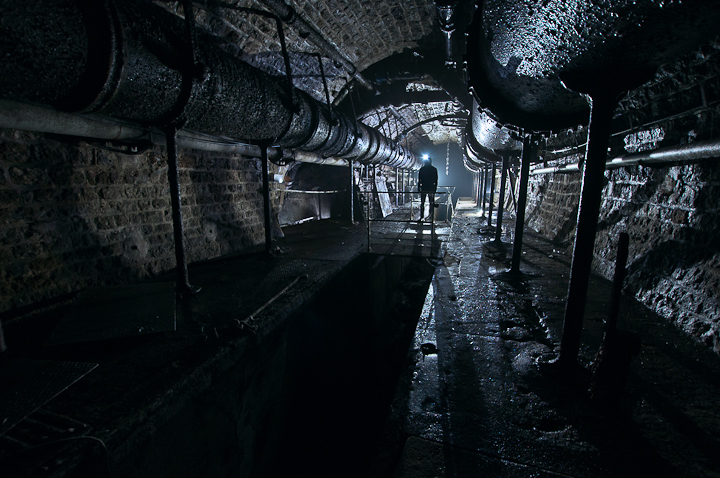
Riding the stream
It’s not often that our explorations are more connected to people than places. However, on a recent trip into the Paris sewer system, we were chasing the ghost of the Parisian eccentric and urban photographer Félix Nadar. For urban explorers in London and Paris, the period between 1850 and 1870, when Nadar was doing his work, is a crucial one. During that time, both of the drain networks were built to the rough configuration in which they remain. This period was pwned by urban planners and engineers like Bazalgette and Haussmann; it was a time of radical urban reconfiguration. Nadar was fascinated by the changes and spent a great deal of time photographing the Paris catacombs and sewers (and taking aerial and erotic photos, but that’s another story), leading many urban explorers to think of Nadar, and his contemporary John Hollingshead in London, as the first drainers. The name Félix Nadar was even a pseudonym – clearly Nadar was part of our crew!
The story of four of us chasing down Nadar’s subterranean haunts last month has already been told by Otter at Silent UK – my particular interest in the man is our affinity with him as an individual interested in the intersections between the city and the body. What I mean to say is: Hollingshead, Nadar and the drainers of the world are cyborgs.
Clik here to view.
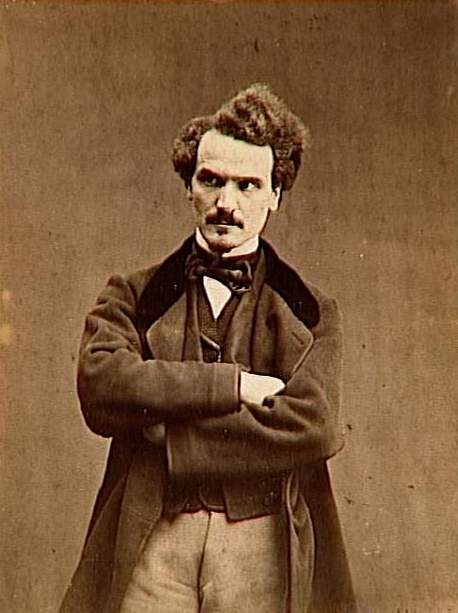
Cyborg drainer
The radical infrastructural urban transformations between 1850 and 1870 were largely due to a massive population spike that led to a Cholera epidemic. Due to long-perceived associations of subterranean space as unhealthy, unclean and evil, citizens held a multitude of beliefs that will engender an obsession with fissures, interstices and imperfect joinings [for] these are the sites of contact through which mephitic exhalations filter out.
Clik here to view.

Mephetic exhalation
These imperfect joinings, when cracked open, were seen as analogous to a flesh wound, the broken skin now ripe for bidirectional infection, the urban body as host, the city’s innards a ripe contamination zone. John Hollingshead, whilst traversing London’s sewer system in 1861, noted that a piece of ordinary rust or of moist red brick is soon pictured as a trace of blood. The contemporary Canadian urban explorer Michael Cook is also obsessed with these pulsing interstitial nodes, though unlike the Victorians, he sees these cracks as opportunities. Cook writes on his site Vanishing Point that the built environment of the city has always been incomplete, by omission and necessity, and will remain so. Despite the visions of futurists, the work of our planners and cement-layers thankfully remains a fractured and discontinuous whole, an urban field riven with internal margins, pockmarked by decay, underlaid with secret waterways. Stepping outside our prearranged traffic patterns and established destinations, we find a city laced with liminality… We find a thousand vanishing points, each unique, each alive…
Cook’s writing hints at the possibility that the structure of the city doesn’t just “seem” alive, it is alive. If architecture and the built environment is a reflection of what we know, then it comes as no surprise that we have constructed our buildings, our cities, as corporal simulacra. At times, these similarities are rendered in front of even the casual observer. For instance, in J.G. Ballard’s novel High Rise, Mrs. Steele referred to the high-rise as if it were some kind of huge animate presence, brooding over them… There was something in this feeling — the elevators pumping up and down the long shafts resembled pistons in the chamber of a heart. The residents moving along the corridors were the cells in a network of arteries, the lights in their apartments the neurons of a brain. Mrs. Steele saw from the street in a fleeting glimpse that which is impossible to ignore once you enter urban infrastructure.
Descending into Cook’s ‘vanishing points’, we enter the city’s bloodstream and begin to witness our effects on the urban metabolism, melding body with machine. Mr. Hollingshead, our Victorian London drainer, had such an encounter while venturing into a drain under a house he once owned on the West End. He wrote that he felt as is the power had been granted me of opening a trap-door in my chest, to look upon the long-hidden machinery of my mysterious body. The connection between his own body and the drain that contained the contents of his body is no fortuitous correlation.
Clik here to view.
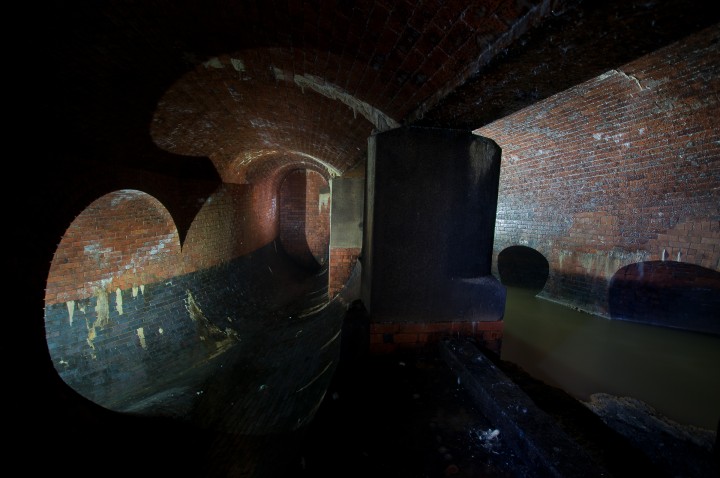
Bodily contents
Now, (stick with me here!) if cybernetics is, as Norbert Weiner declared, the revision of information through the exchange of information and the moments of encounter between our bodies and the urban infrastructure alter either physical structure or mental conceptions where “…the body (as a cultural product) transforms, reinscribes the urban landscape according to its changing (demographic, economic, and psychological) needs, extending the limits of the city, the sub-urban, then Matthew Gandy is right to assert that the emphasis of the cyborg on the material interface between the body and the city is perhaps most strikingly manifested in the physical infrastructure that links the human body to vast technological networks.
Clik here to view.
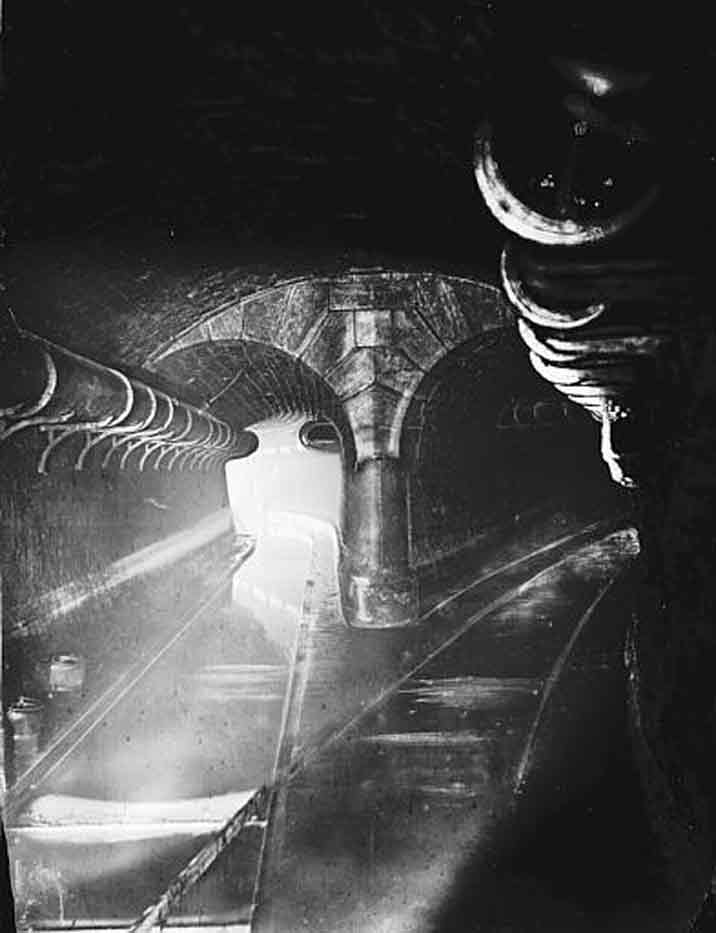
Older than us, but of us
Victor Hugo also wrote about Paris with the passion of one who had been it it’s bowels, leading him to declare that Paris has another Paris under herself; a Paris of sewers; which has its streets, its crossings, its squares, its blind alleys, its arteries, and its circulation, which is slime. Victor Hugo, like us, like Nadar, like Hollingshead was an inner space nanobot, a cyborg surfing the fresh.
Clik here to view.
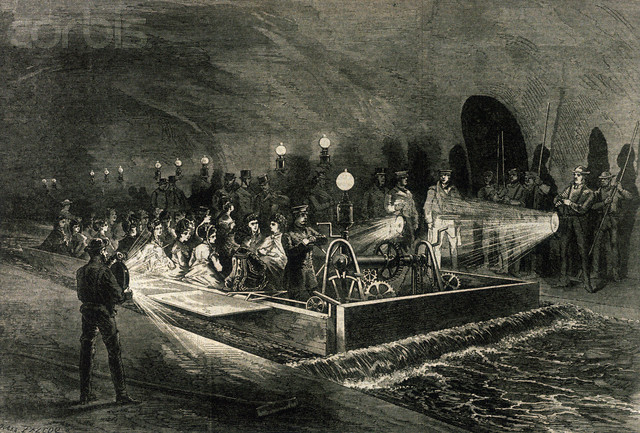
Surfing the fresh
Sewers contain a steady stream of biological packets, full of data connecting nodes, throbbing veins, arterial chambers. The data bloodstream, like light-driven information packets, connect cyborgs, hybrid creature[s], composed of organism and machine. Beyond the designation of the cyborganism, it’s defining characteristic being a propensity to slip the net of a world structured by boundaries and enclosures to a world dominated, at every scale, by connections, networks, and flows, is a possibility for transplantation, a symbiotic bilateral exchange of potentiality. Here, the boundaries between the organic and the inorganic, blurred by cybernetic and bio-technologies, seem less sharp; the body, itself invaded and re-shaped by technology, invades and permeates the space outside, even as this space takes on dimensions that themselves confuse the inner and the outer, visually, mentally and physically where “thought-as-imagination’ departs from the actual, dips into the fractal abyss, then actualizes something new. What is it that is new here you ask? Well nothing more than an animation of the inanimate, a tangible hauntology, an acknowledgement that building forms spring out of historical contingencies – but, given enough time, they may create their own form of subjectivity. Drains are material manifestations of our dreams (including nightmares) but also regulators of our physical potentiality and protectors of the realm in glistening armour.
Clik here to view.
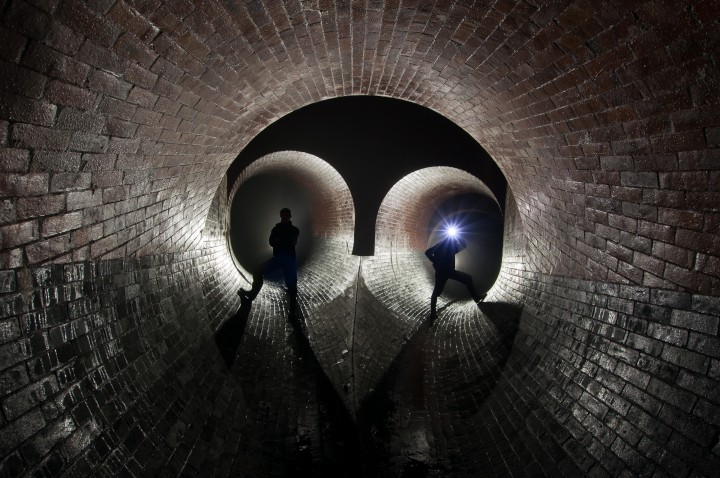
Draining subjectivity
Before the accusations of theoretical posturing ensue, let us reinforce the role of embodiment here, (under)grounding the theory. Bookmarked in each photo we snap are moments of not just conceptual but actual encounters that take place between urban bodies and urban infrastructures, leading to the designation of urban infrastructure as urban body. The result of those bodily encounters is the construction of those webs, flows, and exchanges that create communities, ideas and cyborganisms. The actual hand-wrought work of constructing and deconstructing that fabric reveals a physicality conjoined with virtuality that is anarchic [in it’s] non-identical proliferation, where the everyday urban inhabitant embeds personal investment into the infrastructural networks, inscribing places through place hacking. The city is a reflection then not only of the physical body but of the sprawl and limitations of human consciousness and ability, potential now augmented by the machines we have created. Urban infrastructure, although restricted by capital investment and spatial constraints, is also constrained and fortified by a human imagination of the deepest chaotic order, it’s operation and moments of rupture as fragmented as urbanity itself. If only we could imagine alien body infrastructure concocted under the influence of Burroughs’ Mugwump juice, then the monstrous resultant fragmentation might finally lead to the schizophrenia we need to proceed.
Elizabeth Grosz argued, in 1996, that computers would change the way the city was structured as we built infrastructural systems not modelled upon machinery but upon virtual systems. However, were not both mechanical functions (compare the piston and valves of the heart) and cybernetic circuitry (the CPU as brain) both modelled on the body? Does not the evolution of those artificial bodies influence our biological bodies (for instance, consider the effect of indoor plumbing on the body)? Does the beautiful conjunction of those bodies and spaces, industrial machines as appendages, computer hardware as corporal augmentation, not create new hybrid bodies which will influence the infrastructure of cities? Will those imperfect joinings that the Victorians feared infect and augment through their mephetic exhalation as promised? If Grosz is right, then the body’s limbs and organs will become interchangeable parts with the computer and with the technologicalization of production.
Clik here to view.

Bloodstream nanobots
The Paris catacombs are perhaps the best Western example of the meld to be expected – a place where humanity has become intricately interwoven into the subterranean infrastructural fabric. Paris culture would undoubtedly suffer with loss of access to those spaces, a co-addictive symbiotic relationship has been built there. The KTAs are proof that just as virtual social systems can be maintained by the multitude, so can physical space. The symbioses is even more profound in places like India where infrastructural space is living space, in Poland where we saw people moving into military ruins or in Cambodia where people are living in graves. Despite arguments of deterritorialisation, the visual, aural, sensual representations created on explorations and residencies in those spaces creates a new emotional cache which can be tapped into for myth-making practices, practical application such as sabotage and, increasingly, simple imaginative stimuli that reterritorialise those spaces with a potential that feeds not only physical constructions but imaginations. As a result, the virtual and physical aspects of urban exploration are inseparable as one network depends on the other. Urban exploration, despite it’s weavings into the mythologies of the sublime, is not an escape from nor a transcendence of the physical, but a challenge to the very boundaries of substance dualisms.
Clik here to view.

Investment
The city is more like a sponge than a solid mass of paved streets and architecture, more like a body than a machine. There are sinkholes; the surface is porous. The conductive material urban fabric facilitates an emotional flow, the bloodstream becoming a conduit for sublime affectual registers in immeasurable doses. Overdose always being a possibility, we teeter on the brink, doing our edgework. We leave horribly hung over and come back again and again, our tolerance for exposure to the pain of the cyborg meld growing each time, our possibility for transcendence growing with each descent.
But what of the opposite exchange on the symbiosis? Returning to our colleague Félix Nadar – how did his photographs influence the function, form and representations of that Parisian bloodstream? How do the technological accelerations that allow myself, Winch, Otter, Marc Explo and countless other explorers to recreate Nadar’s work and spin replicative experiential simulacra, in distinct imbricating temporal iterations, begin to mutate those systems? We know it to be true and this is where the accusations of urban exploration being primarily a spectator sport fall flat. Urban exploration can never be purely representational or apolitical. Our work, just like those drainers of 150 years ago, create open systems where they once were closed. Urban explorers reveal the framework and recode the urban landscape daily. Drainers reveal not only the cracks and gaps that exist through the representations they produce but expand those cracks and gaps through repeated exploitation and exploration. Urban exploration and draining realises potentials for cyborgian conceptions of the city to emphasize the continuing political salience of the public realm. Predator’s call for public access to public works is a call for open source urban coding. Where the environment is written in closed code, we’ll hack it until it’s open source again.
Where do we go from here? If we think of urban infrastructure as a tangible network of cybernetic organs, we must then assume the evolution of the information city to be, increasingly, a body without organs, a cloud-computing bot. Inevitably then, if form follows function, human bodies will shed organs just as the city inevitably will. Instead of injecting ourselves into the bloodstream, we will collapse the veins, and our synthetic dreams, rather than our synthetic physicalities, will become the new sites of exploration. We must prepare to kill our darlings.
Clik here to view.

It's still sublime isn't it?
It is time. Explore everything. Blow the veins.